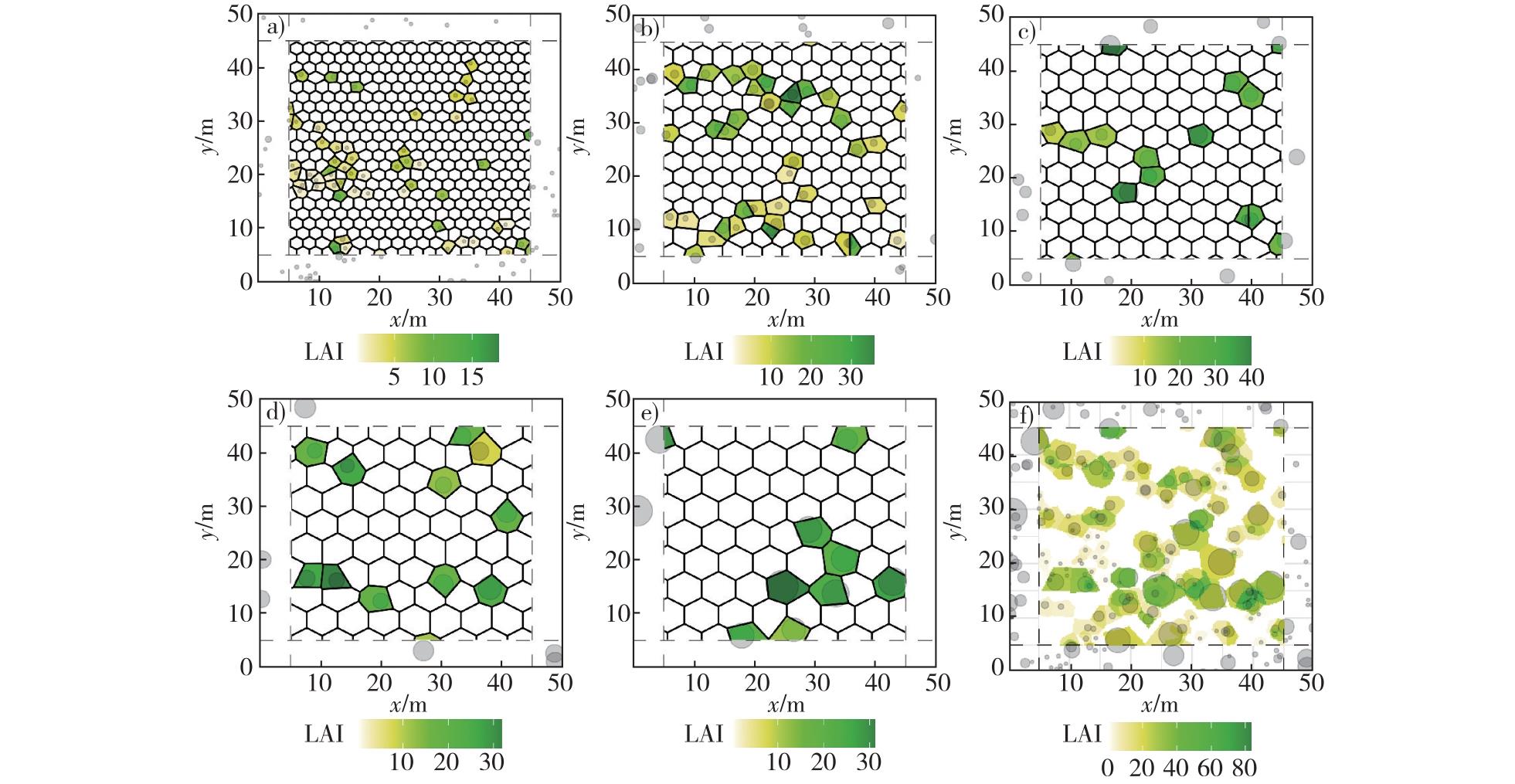 PDF(2261 KB)
PDF(2261 KB)


A study of the vertical and short-range horizontal spatial distribution of leaf area index in broadleaved-Korean pine forest based on stratified Voronoi diagrams
DU Xin, DONG Xue, GU Huiyan, CHEN Xiangwei
Journal of Nanjing Forestry University (Natural Sciences Edition) ›› 2025, Vol. 49 ›› Issue (3) : 83-94.
 PDF(2261 KB)
PDF(2261 KB)
 PDF(2261 KB)
PDF(2261 KB)
A study of the vertical and short-range horizontal spatial distribution of leaf area index in broadleaved-Korean pine forest based on stratified Voronoi diagrams
【Objective】This study aims to investigate the vertical and short-range horizontal spatial distribution patterns of leaf area index (LAI) in broadleaved-Korean pine forests and explore the application value of the stratified Voronoi diagram method in simulating the spatial distribution of LAI in multi-storey forest ecosystems.【Method】The study focused on the virgin broadleaved-Korean pine forest located on the downhill side of the core zone of Liangshui National Nature Reserve. The trees within the forest stand that reached the minimum diameter at breast height (5 cm) were divided into five height classes (Class Ⅰ, H < 10 m; Class Ⅱ, 10 m ≤ H < 15 m; Class Ⅲ, 15 m ≤ H < 20 m; Class Ⅳ, 20 m ≤ H < 25 m; Class Ⅴ, H ≥ 25 m).The Voronoi diagram method was used to simulate the spatial distribution of LAI in different height classes within the forest. The results were combined to form an overall spatial distribution of LAI for the forest stand. Furthermore, the overall characteristics of LAI at the forest stand scale were analyzed, including the vertical distribution patterns of LAI for different tree species and the entire forest stand. The short-range horizontal spatial autocorrelation patterns of LAI at different height classes and the overall forest stand were analyzed using the spatial semivariance function and incremental spatial autocorrelation method. 【Result】Three results were obtained. First, the overall LAI of the study plot was 10.807, with Pinus koraiensis, Acer momo, Betula platyphylla, Tilia amurensis and Fraxinus mandshurica making the top five contributions to the stand LAI. The local LAI in the understorey varied within the range of 0-75, with 48.7% of the understorey having a LAI of 0. The probability density histogram of the LAI in the area with canopy cover had a single-peak distribution, with the peak between 15-25. Second, the LAI of broadleaved-Korean pine forest was 0.420, 2.420, 2.210, 2.707 and 3.050 from height class I to height class V respectively, with vertical distribution tendency degree of total LAI in the stand being 1.171 and the coefficient of variation of total LAI in different height classes being 47.3%. From height class Ⅰ to Ⅴ, the number of canopy patches was 53, 39, 12, 11, and 8 respectively. The LAI under the canopy patches of each species showed an increasing trend as the height level increased. Third, the Nugget value, Sill value, range and Nugget/Sill ratio of the spatial semi-variance function of LAI in broadleaved Korean pine forest were 4.770, 164.010, 5.108 m and 0.029, respectively. The LAI was similarly clustered at lag distances less than 27.0 m and greater than 38.5 m, and spatially random at lag distances between 27 m and 38.5 m (P<0.05). As the lag distance gradually increased, the Z-score of the LAI showed two peaks at 14 and 24 m.【Conclusion】The LAI of broadleaved-Korean pine forests in gentle slope positions exhibits distinct vertical stratification. The leaf area of different tree species tends to be distributed at different heights. For instance, Pinus koraiensis, Picea asperata, and Fraxinus mandshurica, as tall arbor species, have their leaf area concentrated in the upper canopy. On the other hand, Acer opalus and Ulmus, representing middle-sized and small-sized arbor species, have their leaf area concentrated in the lower canopy. The LAI of broadleaved-Korean pine forests in lower gentle slope positions exhibits strong short-range spatial autocorrelation in the horizontal direction. The horizontal spatial distribution of LAI within the forest stand was similarly clustered at most research scales, which is strongly influenced by the spatial distribution of trees.

broadleaved-Korean pine forest / leaf area index / Voronoi diagram / vertical distribution tendency degree / spatial autocorrelation
| [1] |
|
| [2] |
方红亮. 森林垂直结构参数实测与遥感研究进展:以叶面积指数和聚集指数为例[J]. 科学通报, 2021, 66(24):3141-3153.
|
| [3] |
|
| [4] |
|
| [5] |
|
| [6] |
|
| [7] |
贺康宁, 田阳, 张光灿. 刺槐日蒸腾过程的Penman-Monteith方程模拟[J]. 生态学报, 2003, 23(2):251-258.
|
| [8] |
|
| [9] |
|
| [10] |
汤孟平, 陈永刚, 施拥军, 等. 基于Voronoi图的群落优势树种种内种间竞争[J]. 生态学报, 2007, 27(11):4707-4716.
|
| [11] |
方景, 孙玉军, 郭孝玉, 等. 基于Voronoi图和Delaunay三角网的杉木游憩林空间结构[J]. 林业科学, 2014, 50(12):1-6.
|
| [12] |
|
| [13] |
徐化成. 中国红松天然林[M]. 北京: 中国林业出版社, 2001.
|
| [14] |
国庆喜. 阔叶红松林林冠斑块特征及其与林木更新的关系[J]. 应用生态学报, 2002, 13(12):1541-1543.
|
| [15] |
惠刚盈,
|
| [16] |
|
| [17] |
董利虎, 李凤日, 宋玉文. 东北林区4个天然针叶树种单木生物量模型误差结构及可加性模型[J]. 应用生态学报, 2015, 26(3):704-714.
|
| [18] |
|
| [19] |
周国逸, 尹光彩, 唐旭利, 等. 中国森林生态系统碳储量-生物量方程[M]. 北京: 科学出版社, 2018.
|
| [20] |
吴炅, 蒋馥根, 彭邵锋, 等. 结合树冠体积的油茶树高与产量估测研究[J]. 南京林业大学学报(自然科学版), 2022, 46(2):53-62.
|
| [21] |
|
| [22] |
|
| [23] |
孙厚云, 卫晓锋, 贾凤超, 等. 冀北承德地区土壤生源要素生态化学计量与空间分异特征[J]. 生态学报, 2022, 42(5):1750-1765.
|
| [24] |
|
| [25] |
|
| [26] |
许开宏, 施招, 马磊超, 等. 基于机载激光雷达与高景一号数据的草原地上生物量反演研究[J]. 草业学报, 2023, 32(5):40-49.
|
| [27] |
|
| [28] |
欧建德. 杈干现象对南方红豆杉树冠形态、生长和形质的影响[J]. 南京林业大学学报(自然科学版), 2023, 47(2):87-94.
|
| [29] |
冷寒冰, 景军, 奉树成. 上海两种常绿阔叶树种生物量分配及异速生长模型[J]. 生态学杂志, 2018, 37(12):3590-3596.
|
| [30] |
|
| [31] |
李文华. 东北天然林研究[M]. 北京: 气象出版社, 2011.
|
| [32] |
邬建国. 景观生态学:格局、过程、尺度与等级[M]. 2版. 北京: 高等教育出版社, 2007.
|
| [33] |
李婷婷, 姬兰柱, 于大炮, 等. 东北阔叶红松林群落分类、排序及物种多样性比较[J]. 生态学报, 2019, 39(2):620-628.
|
/
| 〈 |
|
〉 |